
Spialia galba, the Indian grizzled skipper, is a hesperiid butterfly which is found in South Asia and parts of Southeast Asia.
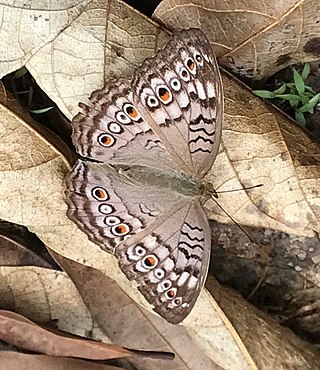
Junonia atlites, the grey pansy, is a species of nymphalid butterfly found in South Asia.

Dodona ouida, the mixed Punch, is a small but striking butterfly found in the Indomalayan realm in West China, Himalayas, Northeast India (hills) and Burma that belongs to the Punches and Judies, that is, the family Riodinidae.
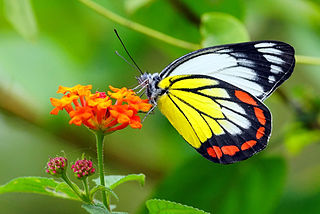
Delias hyparete, the painted Jezebel, is a medium-sized butterfly of the family Pieridae, found in South Asia and Southeast Asia.

Appias indra, the plain puffin, is a small butterfly of the family Pieridae, that is, the yellows and whites, which is found in south and southeast Asia.

Hypolimnas misippus, the Danaid eggfly, mimic, or diadem, is a widespread species of nymphalid butterfly. It is well known for polymorphism and mimicry. Males are blackish with distinctive white spots that are fringed in blue. Females are in multiple forms that include male-like forms while others closely resemble the toxic butterflies Danaus chrysippus and Danaus plexippus.

Parascotia fuliginaria, the waved black, is a species of moth of the family Erebidae. It is found in Europe as far east as the Ural Mountains, in Armenia and Asia Minor, and is an introduced species in North America.

Cosmopterix is a large genus of moth in the family Cosmopterigidae.

Entephria caesiata, the grey mountain carpet, is a moth of the family Geometridae. The species was first described by Michael Denis and Ignaz Schiffermüller in 1775. It is found in the mountainous areas of Europe, the Caucasus, Asia Minor, Armenia, Russia, Russian Far East, Siberia, northern Mongolia, Sakhalin and Honshū in Japan.

Junonia iphita, the chocolate pansy or chocolate soldier, is a butterfly found in Asia.

Cosmopterix etmylaurae is a moth of the family Cosmopterigidae. It is known from Costa Rica.
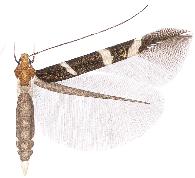
Cosmopterix trifasciella is a moth of the family Cosmopterigidae. It is known from Ecuador.

Libythea laius, the lobed beak, is a member of the butterfly subfamily Libytheinae found in East Africa, Madagascar, southern India, and Sri Lanka. It was described by Roland Trimen in 1879.

Filatima obidenna is a moth of the family Gelechiidae. It is found in North America, where it has been recorded from Arizona.
Leuronoma textifera is a moth of the family Gelechiidae. It was described by Edward Meyrick in 1913. It is found in South Africa.

Helophilus fasciatus, the narrow-headed marsh fly, is an abundant species of syrphid fly observed throughout the United States and Canada. Hoverflies can remain nearly motionless in flight. The adults are also known as flower flies for they are commonly found on flowers, from which they get both energy-giving nectar and protein-rich pollen. The larvae of this genus are associated with wet decaying organic material, particularly accumulations of decaying vegetation in ponds and mud and farmyard manure or silage. The adults of this species lays eggs on vegetation overhanging the water. The larvae hatch and drop into the water.
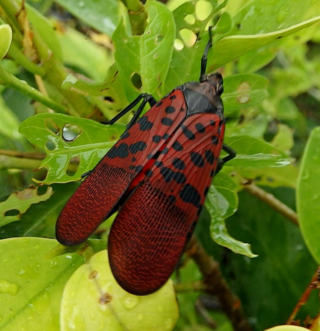
Lycorma meliae is a planthopper species endemic to Taiwan, with multiple, dramatically different color morphs depending on the life stage. The species was described by Masayo Kato in Taiwan in 1929, and is the only member of its genus confirmed to be native to the island. In 1929, a specimen of L. meliae was originally described as a separate species, L. olivacea, also by Kato. These two taxon names were declared synonymous in 2023. L. meliae undergoes four instar stages before achieving adulthood and specimen generally only survive till the winter.
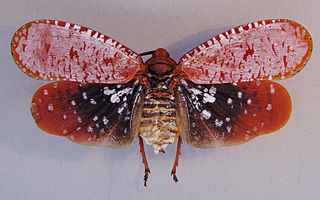
Aphaena submaculata is a species of planthoppers in the sub-family Aphaeninae of Fulgoridae. Various subspecies are distributed throughout the Indo-China region. The species was first observed by Frederick William Hope in 1840 and was formally described by James Duncan in 1843. Since then, it has undergone multiple reclassifications and now has 3 recognized subspecies which differ by color and/or length. The species feeds on tree sap via specialized mouthparts and follows a hemimetabolous life cycle.

Amantia imperatoria is a species of lanternfly found in Costa Rica and Panama.
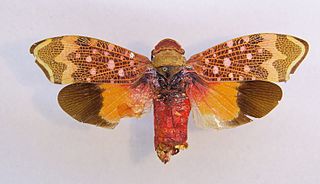
Amantia combusta is a species of lanternfly found in Colombia and Ecuador. It is also found in Venezuela.
















